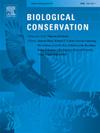由于城市化、农业和有蹄类动物的活动,哺乳动物群落的同质化受到了灌丛地的保护
IF 4.4
1区 环境科学与生态学
Q1 BIODIVERSITY CONSERVATION
引用次数: 0
摘要
在上个世纪,美国中西部一直处于城市和农业用地转换的前沿,这极大地侵蚀了生物多样性,改变了哺乳动物群落的组合。为了比较生态驱动因素对该景观中哺乳动物群落特征的影响,我们在伊利诺伊州使用了一个在秋季和春季之间部署的全州范围的摄像机捕获网络,历时三年。我们使用线性和广义加性模型对160个站点的位置、规模、形状、排序和筑巢温度进行分析,以确定哺乳动物多样性和群落组成的驱动因素。我们发现哺乳动物多样性与城市化之间存在微妙的关系,不透水表面降低了丰富度和多样性,而人类足迹增加了多样性。白尾鹿(Odocoileus virginianus)和农用地覆被与群落均匀度降低和非结构化群落增加相关,而灌木覆被对群落丰富度、均匀度和多样性有积极影响。我们没有发现土狼(Canis latrans)对哺乳动物多样性的负面影响的有力支持,可能是因为土狼的抑制作用主要局限于同域犬科动物。我们的研究结果强调了哺乳动物群落与人为扩张之间的复杂关系,同时也证明了食草性等生态过程在哺乳动物群落的形成中发挥了重要作用。因此,成功地保护哺乳动物的多样性,除了保护自然栖息地,包括被低估的栖息地,如灌木丛,可能还需要有蹄类动物的种群管理。本文章由计算机程序翻译,如有差异,请以英文原文为准。
Shrublands act as refugia against the mammal community homogenization driven by urbanization, agriculture, and ungulate browsing
The American Midwest has been at the forefront of urban and agricultural land conversion in the last century, which has dramatically eroded biodiversity and altered mammal community assemblages. To compare the effects of ecological drivers on the characteristics of mammal communities in this landscape, we used a statewide camera-trapping network deployed between autumn and spring for three years in Illinois. We used linear and generalized additive models for location, scale, and shape, ordination, and nestedness temperature analysis to determine drivers of mammal diversity and community composition across >160 sites. We found a nuanced relationship between mammal diversity and urbanization, with impervious surface reducing richness and diversity, while human footprint increased diversity. White-tailed deer (Odocoileus virginianus) and agricultural land cover were associated with reduced community evenness and more unstructured communities, while shrubland cover had positive effects on richness, evenness, and diversity. We did not find strong support for the negative effects of coyotes (Canis latrans) on mammal diversity, likely because suppressive effects from coyotes are largely limited to sympatric canids. Our results highlight the complex relationships between mammal communities and anthropogenic expansion, while demonstrating that ecological processes such as herbivory can play an important role in shaping mammal communities. Successfully conserving mammalian diversity, therefore, may require ungulate population management in addition to preserving natural habitat, including undervalued habitat such as shrubland.
求助全文
通过发布文献求助,成功后即可免费获取论文全文。
去求助
来源期刊

Biological Conservation
环境科学-环境科学
CiteScore
10.20
自引率
3.40%
发文量
295
审稿时长
61 days
期刊介绍:
Biological Conservation is an international leading journal in the discipline of conservation biology. The journal publishes articles spanning a diverse range of fields that contribute to the biological, sociological, and economic dimensions of conservation and natural resource management. The primary aim of Biological Conservation is the publication of high-quality papers that advance the science and practice of conservation, or which demonstrate the application of conservation principles for natural resource management and policy. Therefore it will be of interest to a broad international readership.
 求助内容:
求助内容: 应助结果提醒方式:
应助结果提醒方式:


